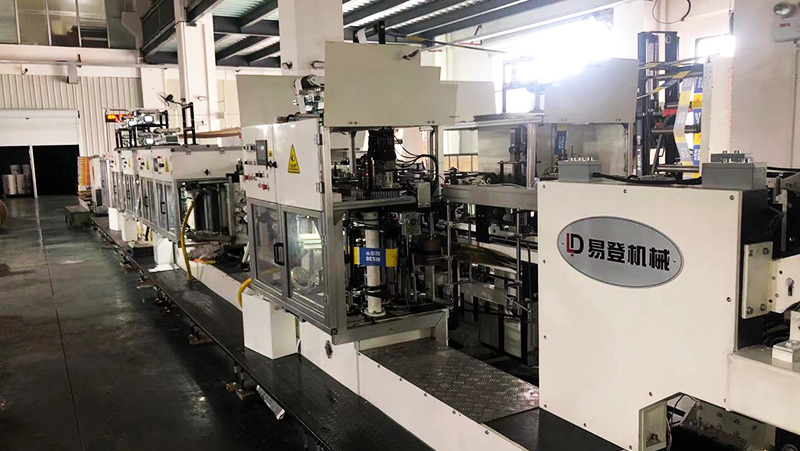The Comprehensive Guide to Block Bottom Paper Bag Machines: Technology, Applications, and Industry Impact
Release time:2025-05-26 Classification:Knowledge
The production of durable, eco-friendly packaging has become a cornerstone of modern manufacturing, driven by global sustainability initiatives and consumer demand. Among the innovations shaping this sector, the block bottom paper bag machine stands out as a critical piece of equipment for producing high-quality, versatile paper bags. This article explores the technology behind these machines, their operational advantages, diverse applications, and their transformative role in the packaging industry.

Understanding Block Bottom Paper Bag Machines
A block bottom paper bag machine is a specialized industrial system designed to automate the creation of paper bags with a reinforced rectangular base. Unlike flat-bottom or pinch-bottom designs, block bottom bags offer superior stability and load-bearing capacity, making them ideal for heavy-duty applications such as food grains, pet food, or construction materials. These machines integrate precision engineering with advanced automation to ensure consistent output, minimal waste, and high-speed production.
Key Components and Workflow
- Paper Feeding System: Rolls of kraft paper or recycled material are fed into the machine, with tension control mechanisms ensuring smooth unwinding.
- Printing Unit (Optional): Some models include inline printing for branding or labeling.
- Tube Formation: The paper is folded and glued into a tubular structure.
- Bottom Creation: A unique folding mechanism forms the block-style base, which is securely sealed using adhesives or heat.
- Cutting and Stacking: Finished bags are trimmed to size and collected for packaging.
Modern machines often feature servo-driven motors, programmable logic controllers (PLCs), and touchscreen interfaces for precise adjustments to bag dimensions, handle attachments, or bottom reinforcement styles.
Technical Advancements Driving Efficiency
Recent innovations in block bottom paper bag machine design have focused on enhancing productivity while reducing environmental impact:
- Energy-Efficient Motors: Lower power consumption without compromising output speeds.
- Adaptive Gluing Systems: Reduced adhesive waste through precision application.
- Smart Sensors: Real-time monitoring of paper alignment, glue levels, and defect detection.
- Modular Configurations: Customizable setups for handles, windows, or multi-layer laminates.
These advancements enable manufacturers to produce up to 120 bags per minute, depending on bag size and complexity, while maintaining strict quality control standards.
Applications Across Industries
Block bottom paper bags are favored in sectors requiring robust, sustainable packaging:
- Food Industry: Flour, sugar, coffee, and dried goods benefit from the bags’ moisture-resistant options.
- Retail: Premium block bottom bags with handles serve as reusable shopping carriers.
- Agriculture: Fertilizers, seeds, and animal feed require durable, stackable packaging.
- Construction: Cement and chemical products utilize heavy-duty reinforced designs.
The adaptability of block bottom paper bag machines allows for variations in paper weight (30–200 GSM), bottom dimensions, and print finishes, catering to niche market needs.
Sustainability and Economic Benefits
As businesses transition from plastic to paper-based solutions, block bottom paper bag machines play a pivotal role:
- Material Compatibility: Works with recycled, FSC-certified, or compostable papers.
- Waste Reduction: Precision cutting systems minimize raw material usage.
- Long-Term ROI: Automated systems lower labor costs and downtime.
A 2023 industry report highlighted that manufacturers using advanced block bottom machines reduced material waste by 22% compared to semi-automated systems.
Maintenance and Operational Best Practices
To maximize the lifespan of a block bottom paper bag machine, operators should:
- Conduct daily lubrication of moving parts.
- Regularly inspect folding blades and sealing units for wear.
- Calibrate sensors and tension controls monthly.
- Train staff on troubleshooting common issues like paper jams or glue inconsistencies.
Proactive maintenance ensures consistent bag quality and avoids costly production halts.
Future Trends in Bag Manufacturing Technology
Emerging trends are set to redefine block bottom paper bag machine capabilities:
- AI-Powered Optimization: Machine learning algorithms predicting maintenance needs.
- Hybrid Material Handling: Integration of biodegradable films or coatings.
- IoT Connectivity: Remote monitoring of production metrics via cloud platforms.
These developments align with global regulations phasing out single-use plastics, positioning block bottom bags as a future-proof packaging solution.
The block bottom paper bag machine represents a synergy of innovation, sustainability, and industrial efficiency. By enabling the mass production of reliable, eco-conscious packaging, this technology addresses both environmental concerns and commercial demands. As industries continue to prioritize green alternatives, investing in advanced block bottom bag manufacturing systems will remain a strategic imperative for businesses aiming to lead in the circular economy era. Understanding the technical nuances and applications of these machines is essential for stakeholders seeking to optimize their packaging workflows and align with global sustainability goals.






